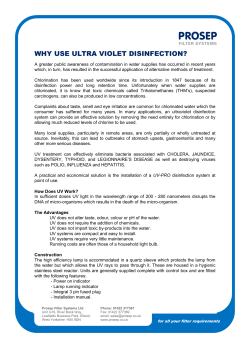
Document 340808
Disinfectant Strategies http://dx.doi.org/10.5991/OPF.2014.40.0061 Andrew Seidel is CEO of Underground Solutions (www.undergroundsolutions.com), Poway, Calif. A California water utility’s desire to move away from the dangers of gas chlorination drove operators and managers to consider bulk hypochlorite delivery and on-site hypochlorite generation as disinfection options. Ultimately, they found an on-site hypochlorite generation system was manageable, got the job done, and made the utility a better neighbor. BY ANDREW SEIDEL W HEN THE CITY OF VACAVILLE, at the city of Vacaville was typical of that found Calif., was presented with the at many utilities: concern over employee safety, opportunity to move away from an aging gas system, increasing levels of regula- chlorine gas disinfection for its tion and scrutiny, and a good-neighbor ethic. 12-mgd water plant, Chief Operator Richard Taking a step back, the chemistry of all three MacLean embarked on a methodical process major chlorine-based disinfection systems is vir- of evaluating bulk-delivered hypochlorite ver- tually identical and relies on the extremely reac- sus on-site hypochlorite generation for disinfec- tive chlorine element. Chlorine in its various tion. Although disinfection with chlorine gas has forms is so reactive that it actually breaches cell the greatest market share of all disinfection sys- walls to produce the desired germicidal effect. tems in North America, movement to either bulk In fact, the introduction of chlorine gas for water sodium hypochlorite or on-site sodium hypochlo- disinfection at the beginning of the 20th century rite generation has been accelerating. The motiva- was one of the most successful public health tion to investigate a switch from gas chlorination advancements of all time. 10 Opflow October 2014 www.awwa.org/opflow PHOTOGRAPHS: ANDREW SEIDEL, UNDERGROUND SOLUTIONS HYPOCHLORITE DISINFECTION CONSIDER AN ON-SITE SYSTEM David Smith, water treatment facilities supervisor at the Olivenhain Municipal Water District, Encinitas, Calif., monitors the utility’s 2,400 lb/d on-site sodium hypochlorite system. Advances in technology, as well as increased security and safety risks associated with chlorine gas, have resulted in on-site sodium hypochlorite generation becoming a more costeffective, proven alternative for disinfection. Disinfectant Strategies BULK HYPOCHLORITE CONCERNS Chlorine gas and liquid hypochlorite form the germicidal hypochlorous acid when mixed with water: Cl2 (chlorine gas) + H2O (water) —> HOCl (hypochlorous acid) + H+ + Cl – NaOCl (sodium hypochlorite or “bleach”) + H2O —> HOCl (hypochlorous acid) + Na+ + OH – Concentration is the only difference between liquid “bulk” hypochlorite and on-site-generated hypochlorite, with bulk supplied as a 12.5 percent concentration of sodium hypochlorite and on-site systems generating a roughly 0.8 percent concentration of sodium hypochlorite. MacLean had a lot of experience operating bulk hypochlorite systems, because the city’s wastewater operations used bulk hypochlorite for disinfection. The relatively high concentration and reactive nature of bulk hypochlorite make transporting and handling the liquid cumbersome and worrisome. Under its health section, the National Fire Protection Association’s rating for bulk hypochlorite states, “Intense or continued exposure could cause temporary incapacitation or residual injury.” The same section for on-site hypochlorite reads, “Exposure may cause mild irritation.” With bulk hypochlorite, operators routinely complained about splash concerns. “Our operators, if not careful, would end up with holes burned in their clothing anytime they had anything to do with handling bulk hypochlorite,” relates Tom Kennedy, general manager of Rainbow Municipal Water District, Fallbrook, Calif. In many cases, the need to consider a plant’s location and adjacent neighborhoods puts bulk shipments of concentrated hypochlorite at a disadvantage. David Smith, water treatment facilities supervisor of Olivenhain Municipal Water District, Encinitas, Calif., stated the district’s concerns about the location of its 12 Opflow October 2014 34-mgd water plant given its proximity to a wildlife preserve and an implicit agreement with neighbors to minimize the use of hazardous materials. “Having tank truckloads of concentrated hypochlorite drive through our service area would be contrary to the operating ethic we have established with our neighbors,” he said. According to MacLean, the more highly concentrated version of hypochlorite is unstable and degrades—particularly in warm weather above 75°F. Such degradation forces operators to frequently test hypochlorite concentrations and adjust metering equipment accordingly. In the Vacaville area, bulk hypochlorite is widely available and reasonably inexpensive. However, even with the degradation and attendant off-gassing, the big advantage for bulk hypochlorite was lower initial capital cost. A bulk system consists essentially of tanks and metering pumps—significantly less complex than an on-site generation system. ON-SITE SYSTEM CONSIDERATIONS MacLean knew his operators had good skills when it came to operating chemical metering equipment and had no operational difficulties with Vacaville’s existing bulk hypochlorite systems. However, operating a more complex on-site sodium hypochlorite system was an unknown. On-site systems generate sodium hypochlorite by applying an electric current to saltwater: NaCl (salt) + H2O + 2e–(electricity) —> NaOCl (sodium hypochlorite) + H2 (hydrogen gas) Essentially, 3 lb of salt is combined with 2 kW of electricity and 15 gal of water to generate 1 lb of chlorine “equivalent” (15 gal of 0.8 percent hypochlorite), with hydrogen gas evolved as a by-product. Salt brine is generated on-site with bulk salt and fed into electrolytic cells (specially coated titanium anodes and cathodes) that generate the hypochlorite solution when powered up. An on-site system may require personnel with more electrical experience. A DC power rectifier provides the direct current for electrolysis. Although the chemical and mechanical aspects of an on-site system might be similar in complexity to a bulk system, adding an electrical component raised some questions. “From my experience, I’d say the operational and maintenance staffing would be similar for either system, with the maintenance for the on-site system potentially requiring personnel with more electrical experience,” suggests Todd Pickle, a chemical engineer for Southern Nevada Water Authority’s 300-mgd River Mountains Water Treatment Facility, Henderson, Nev., which has nine on-site units that can each generate 2,000 lb of chlorine equivalent per day. INITIAL STEPS MacLean set about determining the unknown operational requirements by procuring a smaller on-site system for a water well that fed the city’s system. After asking for information and price quotes from three system providers, he found that two of the three had good local references and, after a field trip with his staff, settled on the provider with more www.awwa.org/opflow In the final analysis, experience in operating both types of disinfection systems led the city to choose on-site hypochlorite generation as the safer and more economical choice for its wells and water plant. After reviewing their options, Vacaville staff ultimately opted to purchase a 400-lb/d on-site sodium hypochlorite system (below). They installed the system themselves in early 2014 (right). California installations and a better customer service record. Within a few months, the city had installed a 20-lb/d system for the demonstration well and was enjoying successful operations. Subsequently, the city added four 40-lb/d on-site units for an additional four well sites. The well-site experience taught MacLean that while operators had to “pay more attention” to the on-site systems than the previous gas systems, the difference in operational tempo wasn’t a burden. “There’s a learning curve for sure, but the added complexity is completely manageable,” he said. DECIDING FACTORS After the team gained confidence by successfully installing and operating onsite units at the well sites, the city felt it could fully evaluate the conversion of the 12-mgd water plant from gas chlorine to either bulk hypochlorite or on-site hypochlorite generation. The utility’s engineering team conducted a cost comparison that included structural modifications (a building to house the gas system and scrubber area), equipment capital costs, www.awwa.org/opflow various economic sensitivity analyses, and vendor support. There’s enormous variability among utilities regarding capital costs, operational costs, and 20-year net-present values for on-site versus bulk systems. However, the variables that need to be carefully considered include the following: ■■ Projected cost of consumables such as salt, power, and concentrated bulk sodium hypochlorite. Bulk hypochlorite may have cyclical price variation, and the availability of good-quality salt could affect on-site projections. As Pickle points out, “Our primary disinfection utilizes ozone, so we need to use more costly low-bromide salt to manage potential bromate levels in the treated water.” ■■ Existing building and layout, with new tanks required in either case. For bulk hypochlorite, curbs and additional containment should be considered. For an on-site system, the generation equipment may need to fit in the existing building. Larger on-site systems will require utilities to carefully design supporting cooling and ventilation systems to ensure optimal thermal conditions. ■■ Sizing the on-site system to take advantage of cheaper off-peak electricity use. ■■ Cost of replacing electrolytic cells for on-site generation systems. Finally, Vacaville’s operations and maintenance, engineering, and administrative staff took another field trip to examine larger systems in operation. The staff ultimately voted in favor of an on-site system, and the city opted to purchase a 400-lb/d on-site sodium hypochlorite system the staff installed themselves in early 2014. In the final analysis, experience in operating both types of disinfection systems led the city to choose on-site hypochlorite generation as the safer and more economical choice for its wells and water plant. “I’m not for being on the bleeding edge,” relates MacLean. “When there’s any doubt, talk to someone who has done it before, and build your own operational know-how.” October 2014 Opflow 13
© Copyright 2025










